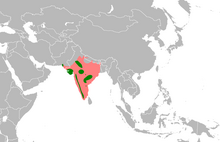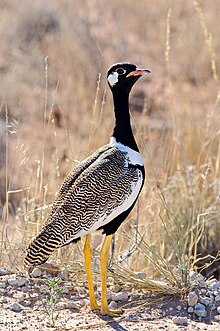| Bengal Florican |
|---|
 |
| Male (standing) and female |
| Conservation status |
|---|

Critically Endangered (IUCN 3.1)
|
| Scientific classification |
|---|
| Kingdom: | Animalia |
| Phylum: | Chordata |
| Class: | Aves |
| Order: | Gruiformes |
| Family: | Otididae |
| Genus: | Houbaropsis
Sharpe, 1893 |
| Species: | H. bengalensis |
| Binomial name |
|---|
Houbaropsis bengalensis
(Gmelin, 1789) |
| Synonyms |
|---|
Eupodotis bengalensis (Gmelin, 1789)
|
The Bengal Florican (Houbaropsis bengalensis), also called Bengal Bustard, is a very rare bustard species from the Indian Subcontinent, with a smaller separate population in Southeast Asia. It is the only member of the genus Houbaropsis. This threatened species is now almost extinct; probably less than 1,000 and perhaps as few as 500 adult birds are still alive.
Description

Adult male taking flight in Kaziranga National Park, Assam (India)
Adult Bengal Floricans range from 66–68 cm (26–27 in) in length and stand around 55 cm (22 in) tall.The male has black plumage from the head and neck to underparts. Its head carries a long lanky crest, and the neck has elongated display plumes. The upperside is buff with fine black vermiculations and black arrowhead markings, and there is a conspicuous large white patch from the wing coverts to the remiges. In flight, the male's wings appear entirely white except for the dark primary remiges. The feet and legs are yellow, the bill and irides are dark.
Females are larger than the males and have a buff-brown colour similar to the males' back, with a dark brown crown and narrow dark streaks down the side of the neck. Their wing coverts are lighter than the remiges and covered in fine dark barring. Immature birds look like females. Adult females weigh around 1.7–1.9 kg (3.7–4.2 lb) against a weight of 1.2–1.5 kg (2.6–3.3 lb) in males.
They are normally silent but when disturbed utters a metallic chik-chik-chik call. Displaying males croak and produce a strange deep humming.
The only bird even remotely similar to adult males of the Bengal Florican are their counterpart from the Lesser Florican (Sypheotides indica). This is a smaller, slimmer-necked bustard overall, and its males have cheek-tufts of plumes with pennant-like tips rather than the crest, and a white band between neck and back. The females are similar, and young Bengal Floricans can be easily mistaken for female Lesser Floricans. The latter have almost white wing coverts however, resembling the males' wing patch.
Distribution and ecology
It has two disjunct populations, one in the Indian subcontinent, another in South East Asia. The former occurs from Uttar Pradesh (India) through the Terai of Nepal to Assam (where it is called ulu mora) and Arunachal Pradesh in India, and historically to Bangladesh. The South East Asian population occurs in Cambodia and perhaps adjacent southern Vietnam. This species is mostly resident on its breeding grounds; around Tonle Sap in Cambodia however, the birds use grasslands near the lake to breed, and move away from the water in the wet season when the breeding grounds are flooded. Similarly, the Terai population seems to move to warmer lowland locations in winter. Migrations are not long-distance, however, and probably are restricted to a few dozen kilometers.
Bengal Floricans live in open tall grassland habitats with scattered bushes. The most important grass species are satintails (Imperata, in particular Cogongrass I. cylindrica), sugarcane (Saccharum, in particular S. munja and Kans Grass S. spontaneum), as well as Desmostachya bipinnata. The birds are usually encountered in the early mornings and evenings and are most easily spotted in the breeding season from March to August, which is when most censuses of the population are conducted. Particular between March and May, when they give their stunning courtship display, males are far more conspicuous than the cryptically-coloured females, which moreover prefer high grassland rich in sugarcane.
Status and conservation
Restricted to tiny fragments of grassland scattered across South and Southeast Asia, the Bengal Florican is the world's rarest bustard. It is known to have become increasingly threatened by land conversion for intensive agriculture, particularly for dry season rice production.Poaching continues to be a problem in Southeast Asia, while the South Asian population is down to less than 350 adult birds, about 85% of which are found in India. The stocks in Southeast Asia are in slightly better shape (though more threatened), numbering perhaps just as many as in South Asia but more probably closer to or even somewhat over 1,000 adults.
The population has decreased dramatically in past decades. It may be that in India the decline is coming to a halt and that stocks in Dibru-Saikhowa and Kaziranga National Parks and Dudhwa Tiger Reserve are safe at very low levels. Still, its global status is precarious and it was consequently uplisted from Endangered to Critically Endangered in the 2007 IUCN Red List.
In Cambodia, it is mostly found in Kampong Thom Province; lesser numbers are found in Siem Reap Province and remnants might persist in Banteay Meanchey, Battambang and Pursat Provinces. Its rate of decline there has, if anything, accelerated in the early 21st century, and the bird's numbers in Southeast Asia might plummet to effective extinction in the early 2010s. The government of Cambodia has taken a significant step towards protecting important habitat for the Bengal Florican. In an effort to save this endangered flagship species from extinction,,otre than 350 square kilometers have been designated as "Integrated Farming and Biodiversity Areas", where land-use practices are adapted that also benefit the Bengal Florican (see below). A public education program to inform schoolchildren about the bird has also been undertaken. At present, the species may persist in the Ang Trapaing Thmor Crane Sanctuary and perhaps Vietnam's Tram Chim National Park, but the South Asian population is not known with certainty from any protected areas.
In Nepal, it is essentially restricted to protected areas, namely Chitwan and Bardia National Parks and Sukla Phanta Wildlife Reserve, maybe in Koshi Tappu and around Koshi Barrage, where its continuing presence as a resident breeder is uncertain. Only the Suklaphanta population has been stable – between about 15 and 20 adults – since the 1980s. The initially larger Chitwan population has been declining at a low rate in the last decades: 8-19 birds were estimated to be present in 1982, but only 10-14 in 2007. The small Bardia population consisted of 8-9 males in 1982, but only 2-4 were sighted in 2007. The small Bardia population might have disappeared entirely around 2008
To prevent global extinction of this unique bird, several biologists are studying its ecology and devising ways how the birds and the local population can coexist. The spectacular courtship display of males has been discussed by many naturalists traveling British India, and in our time attracts tourists who provide revenue to locals. Among the most significant results of the scientific study of the Bengal Florican was the realization that it is not a particularly shy or hemerophobic species, its apparent intolerance of human settlements being chiefly due to its intolerance of land clearance for agriculture. Pastures and the traditional use of common land for villagers' tall-grass harvest (for construction and handicraft) actually seem to be tolerated quite well by the birds.
If firewood and timber is collected from grassland rather than from forests, human land use will even benefit the species. In particularly Sal (Shorea robusta) and Saj (Terminalia elliptica) have been identified as trees that encroach upon the florican's habitat in Nepal, and its decline in Bardia National Park is probably chiefly due to insufficient use of trees that overgrow grassland. A sustainable land-management technique that will bolster Bengal Florican stocks consists of harvesting grass and particularly wood from changing tracts of land, leaving some areas unharvested each year and setting aside a few additional ones as reserve land, where grasses can grow tall for years until they are harvested. Controlled burning may be necessary when woodland encroachment is strong; it should take place before March, so that the year's offspring are not harmed.























